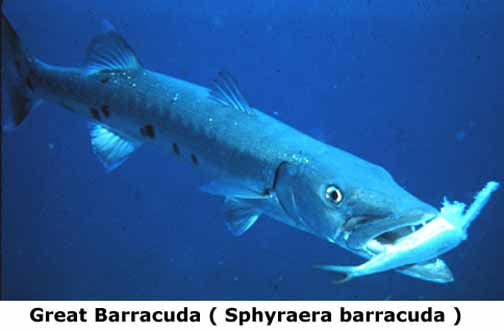Living organisms are composed of cells. These basic units of life contain all the chemicals necessary to support life and pass along hereditary information. To understand the wide variety of organisms that inhabit the sea, it is necessary to know something about the chemicals that make up cells and the cells themselves.
Some of the most important chemicals in living organisms are large molecules called macromolecules. There are four major classes: carbohydrates, lipids, proteins, and nucleic acids.
Carbohydrates contain the elements carbon, hydrogen and oxygen. The most common in living organisms are sugars and polysaccharides.

Glucose is an important sugar that is used by marine organisms, such as a fish,as a source of energy.
Lipids- Fats, oils and waxes are all examples of lipids. Many contain molecules called fatty acids. Simple fats or triglycerides are composed of three fatty acids attached to a carbohydrate molecule known as glycerol. Marine organisms use triglycerides to store energy, to cushion vital organs and to increase buoyancy.
This young whale is insulated from the cold by a thick layer of blubber that is composed of triglyceride fat.
Proteins-polymers made up of basic units called amino acids. Twenty different amino acids make up the various proteins found in living organisms. The number and type of amino acids determine the characteristics of protein molecules. Within cells, individual amino acids are assembled into chains called polypeptides. The complex structures of protein molecules allow them to serve several functions. For instance the primary structural components of animals, muscles and connective tissues are composed of protein. Proteins known as enzymes are essential for life. They speed up the rate of chemical reactions allowing metabolism to function efficiently.

The muscles that allow this pelican to fly are composed of protein.
Nucleic Acids- are polymers of molecules called nucleotides. Each nucelotide is composed of five-carbon sugar, a nitrogen containing base and a phosphate group. There are two types of nucleic acids found in living organisms: deoxyribosenucleic acid(DNA) and ribonucleic acid (RNA)
DNA is a large molecule with the shape of a helix. Each nucelotide found in DNA contains the sugar deoxyribose and one of the following four nitrogen containing bases: adenine, guanine, cytoisine or thymine. DNA contains an organisms genetic material or genes as is capable of copying itself so the genes can be passed from one generation to another.
RNA is composed of nucelotides that contain the sugar ribose and the same bases found in DNA , with the exception that in RNA the base uracil takes the place of thymine. RNA is usually single stranded.
All organisms are composed of cells and every cell is capable of the basic processes of life: metabolism, growth and reproduction.
There are two types of cells in nature: Prokaryotic and Eukaryotic cells.
Prokaryotic cells lack a nucleus and do not have any membrane bound organelles. Organisms with prokaryotic cells are called Prokaryotes.
Eukaryotic cells have wells defined nucleus and many membrane bound organelles. Organisms with eukaryotic cells or eukaryote can be either unicellular or multi cellular.
All cells reproduce by a process of cell division, giving rise to new cells. In multi cellular organisms, groups of like cells form tissues. Different tissues combine to form organs, and organs can combine to form organ systems.
Evolution is the process by which the genetic composition of populations of organisms changes over time.
Natural selection favors the survival and reproduction of those organisms that possess the variations that are best suited to their environment.
A species is a group of physically similar, potentially interbreeding organisms that share a gene pool, are reproductively isolated from other such groups, and are able to produce viable offspring.
The binomial system of nomenclature uses two words, the genus and species epithet to identify an organism.
Most biologists classify organisms into one of three domains, categories that reflect theories about evolutionary relationships.
"Sea" you real soon!!!


.jpg)
No comments:
Post a Comment